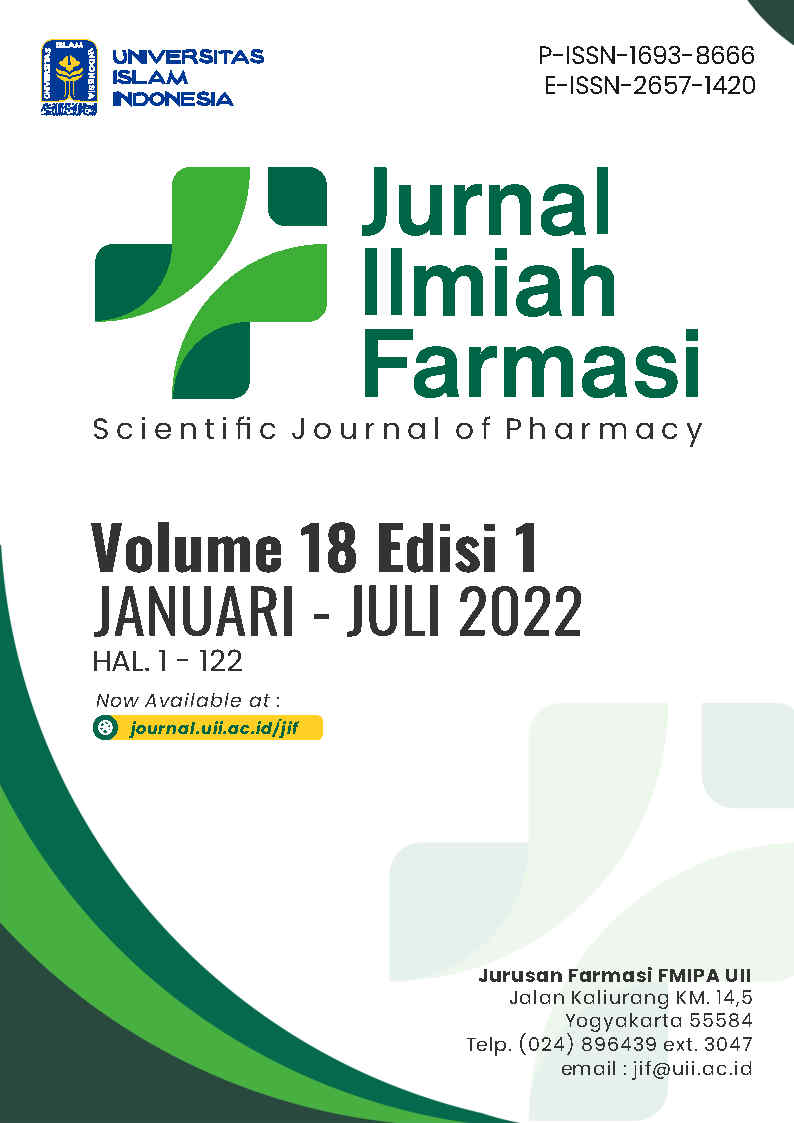Main Article Content
Abstract
Background: Hyperpigmentation is a condition in which increased melanin production causes the formation of dark spots and lesions on the face. Antioxidants are used to reduce melanin production. Telang flowers have an antioxidant potential because it contains anthocyanins and other flavonoids. The potential of telang flowers is important to be recognized as a source of natural antioxidants that inhibit hyper-pigmentation on the skin due to UV exposure.
Objective: To learn about the potential of telang flowers (Clitoria ternatea L.) as an inhibitor of skin hyperpigmentation due to UV exposure
Methods: Data was collected using a systematic review method. The data was obtained from Google Scholar, ScienceDirect, and PubMed databases with the keywords “Clitoria ternatea L. antioxidant activity”; “phytochemical analysis of Clitoria ternatea”; “traditional use of Clitoria ternatea L”; “protective UV effect of Clitoria ternatea L.
Results: Flavonol glycosides are the most common flavonoids found in telang flowers. Flavonoids exhibit antioxidant properties by counteracting the formation of free radicals caused by UV radiation in the melanin biosynthetic pathway. In addition, flavonoids act as metal chelators on tyrosinase, thereby inactivating tyrosinase during melanogenesis. Telang flowers also have the ability to absorb UV-B and UV-C, playing a role in modulating the protective effect against UVR exposure on the skin.
Conclusion: Telang flowers have the potential as an inhibitor of skin hyper-pigmentation due to UV exposure.
Keywords: Antioxidant, telang flower, hyper-pigmentation, ultraviolet
Intisari
Latar belakang: Hiperpigmentasi merupakan keadaan bertambahnya produksi melanin yang menyebabkan terbentuknya lesi dan noda hitam pada wajah. Antioksidan diketahui dapat digunakan untuk mengurangi produksi melanin. Bunga telang memiliki potensi antioksidan, karena terdapat antosianin dan flavonoid lainnya. Potensi bunga telang penting diketahui sebagai sumber antioksidan alami penghambat hiperpigmentasi pada kulit akibat paparan sinar UV.
Tujuan: Untuk mempelajari mengenai potensi bunga telang (Clitoria ternatea L.) sebagai penghambat hiperpigmentasi kulit akibat paparan sinar UV
Metode: Pengumpulan data dilakukan menggunakan basis data Google Scholar, Science Direct dan PubMed dengan kata kunci “Clitoria ternatea L. antioxidant activity”; “phytochemical analysis of Clitoria ternatea”; “traditional use of Clitoria ternatea L”; “protective UV effect of Clitoria ternatea L.
Hasil: Flavonol glikosida merupakan flavonoid yang paling banyak dijumpai pada bunga telang. Flavonoid menunjukkan sifat antioksidan dengan menangkal pembentukan radikal bebas yang disebabkan oleh radiasi UV pada jalur biosintesis melanin. Selain itu, flavonoid bertindak sebagai pengkelat logam pada tirosinase, sehingga menonaktifkan aktivitas tirosinase selama melanogenesis. Bunga telang juga memiliki kemampuan dalam menyerap UV-B dan UV-C yang berperan dalam memodulasi efek perlindungan terhadap paparan UVR pada kulit.
Kesimpulan: Bunga telang memiliki potensi sebagai penghambat hiperpigmentasi kulit akibat paparan sinar UV.
Kata kunci: Antioksidan, bunga telang, hiperpigmentasi, sinar ultraviolet
Article Details
Copyright (c) 2022 Jurnal Ilmiah Farmasi

This work is licensed under a Creative Commons Attribution-NonCommercial 4.0 International License.
Authors who publish in the Jurnal Ilmiah Farmasi agree to the following terms:
- Authors retain copyright and grant Jurnal Ilmiah Farmasi right of first publication with the work simultaneously licensed under a Creative Commons Attribution Licence that allows others to adapt (remix, transform, and build) upon the work non-commercially with an acknowledgement of the work's authorship and initial publication in Jurnal Ilmiah Farmasi.
- Authors are permitted to share (copy and redistribute) the journal's published version of the work non-commercially (e.g., post it to an institutional repository or publish it in a book), with an acknowledgement of its initial publication in Jurnal Ilmiah Farmasi.





